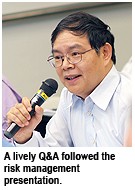CityU takes steps to embrace risk management
Risk management is set to play a vital role in the future development of universities and a robust risk management process brings many benefits.
That was the message presented by a team from the
CityU takes the issue of risk management seriously and is keen to learn from teams at other universities to ensure CityU continues to thrive as a centre of excellence.
Mr John Green, Assistant University Secretary and Risk Management Co-ordinator, and Ms Marina Bland, Risk Management Officer, both at the U of M, discussed during their two-hour talk on 27 October their experience setting up a risk management culture at the U of M.
They set out to define what is meant by risk management, explain its role within a university, and identify the challenges and rewards of implementing risk management strategies and encouraging a culture of risk management within an organization.
“We are here to share our experiences,” Mr Green said. The team is meeting senior management, the Management Board (MB) and the Risk Management Committee during their four-day visit.
In discussing the implementation of a risk management strategy, both members of the team exercised caution. While both were enthusiastic about the benefits of an embedded risk management culture, they said any introduction of any new concepts and policies could prove overwhelming if not handled appropriately.
“Risk management has to be introduced gently,” Ms Bland said. “We need to take small steps.”
Risk management strategies would have to be well planned, well resourced, and supported by senior management and academic and administrative staff, Mr Green added.
At the start of his talk, Mr Green said that although the term ‘risk management’ was relatively new to
“We all do risk management in some way,” he said. “We all decide to make decisions. We weigh up the outcomes and decide what the risks are and the likelihood or possibility of damage.”
What was relative new, he said, was the focus of risk management on universities, since risk management was more usually associated with large corporations, he said.
“The prominence is now on universities, though, because they are experiencing major changes in the way they operate,” he said.
Many of these changes are similar to challenges facing CityU. A growing number of overseas students, a drop in government funding, and a greater emphasis on the commercialization of technologies and products, were three examples the team suggested.
“I think many of those aspects, in particular the changes in teaching modes and commercialization, are particularly relevant to CityU and are going to have to be carefully managed as we go forward,” Mr Green said.
Having defined risk management as the likelihood of ‘occurrence’ against ‘impact’ and ‘consequence’, the team cited some examples of the kinds of risks universities faced: failure to attract and retain staff, failure to attract research funding, plagiarism and the possibility of theft or fraud.
The benefits of risk management, they said, included the demonstration that the University was operating sound corporate governance practices; improved decision making and accountability; effective allocation of resources; focusing on asset management and reputation; and financial benefits.
“Risk management is about good practice,” Ms Bland said.
The process of implanting risk management meant embedding the concept in all management activities and engaging all key stakeholders. Raising awareness took time but, speaking about the U of M experience, risk management strategies would eventually become part of the university culture, Mr Green said.
Raising awareness took place through training, workshops, website development, networking and articles in the U of M’s newsletters.
Both members of the team said the introduction of risk management processes at CityU would put CityU at the forefront of other universities in
The visit was arranged by the Risk Management Committee, which was appointed by the President in response to a proposal from the Audit Committee in April this year that the MB introduced a risk management policy and associated mechanisms to identify and monitor risks.
After the visit by the team from the U of M, the Committee will consider whether to engage it, or other external experts, to provide consultancy services on the development of a risk management policy and associated mechanisms.
The team from the U of M planned to submit a report on their visit to CityU to the Committee in early December, they said.



